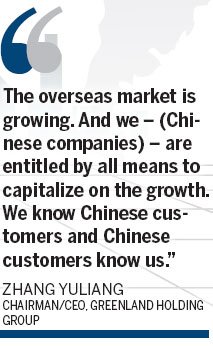By China, for China
Updated: 2013-09-20 15:30
By Emma Dai(HK Edition)
|
|||||||
Chinese investors have roamed the world in recent years, picking up whatever hot properties fall within easy reach of their spreading affluence. Now, property developers are following in the footsteps of well-to-do investors to expand their fortunes in far-flung places. Emma Dai reports.
"This is a great opportunity to pave our way to foreign markets," said Zhang Yuliang on Aug 27 in Hong Kong, when Shanghai-based developer Greenland Holding Group listed its unit on the Hong Kong Stock Exchange.
In keeping with the renowned efficiency of Chinese developers, Greenland Holding Group - a Fortune 500 company - inked a 12-billion yuan ($1.96 billion) deal the very same day with Dhanin Chearavanont, Southeast Asia's wealthiest person and chairman of the Thai conglomerate Charoen Pokphand Group.
Zhang, chairman and CEO of Greenland, relishing a fresh start in a new country, plans to construct 800,000 square meters of high-end residential properties including serviced apartments, mixed-use developments and holiday resorts in Bangkok and the popular beach resort of Pattaya.


"We are accelerating the rate of international expansion. From now to year's end, we will sign and commence more projects," he adds. "The 10 billion yuan investment target we set for 2013 proved too conservative. We are going to exceed that by a significant amount and we'll keep steaming over the next two to three years."
With massive plans unfolding, the State- owned developer is moving aggressively, planting flags around the globe. In May it acquired control of a Frankfurt hotel at the heart of the city's financial center from Melia Hotels International, Spain's biggest hotel chain. Two months later, it pocketed two more hotels in Madrid and Barcelona through an asset swap with the same group. On July 26, Greenland acquired a 25,600-square-meter site in downtown Los Angeles for $1 billion - Chinese developers' biggest deal in the US. A hotel, office units, serviced residences and high-end homes are earmarked for construction, which starts in six to nine months. On Jeju Island, North Korea's top resort, over 80 percent of the first phase of the company's township project has been sold. And in central Sydney, Australia, its $600 million, 60-story residential tower, the tallest in the city, goes on sale next month.
Zhang might be one of the leaders of the pack, but the field of participants has been no less eager in the race to penetrate overseas markets. The clarion call has seen Chinese developers rush out across the Atlantic and Pacific in search of hot properties.
China Vanke, the country's foremost home builder, tied the knot with Singapore's Keppel Land in April. For S$135.5 million ($107 million), Vanke acquired a 30 percent stake in a condominium project in Singapore's Tanah Merah. In February, China Vanke joined with New York-based Tishman Speyer, owner of the Chrysler Center and Rockefeller Center, as a management partner and financial investor in the construction of a $620 million high-rise luxury residential development at 201 Folsom Street, San Francisco. The project is Vanke's first in the US market.

In June, Wanda, a Dalian-based developer operating 34 luxury hotels across China, announced it was making a 700 million ($1.11 billion) investment in London, to build a waterfront hotel near Battersea Power Station. Guangdong-based Country Garden, a smaller but earlier bird to overseas development, headed by China's richest women, 32-year-old Wang Huiyan, is already organizing buyers' groups to visit its 23-hectare flagship residential project in Johor, Malaysia.
Odd though it may sound, hyperactive developers are marketing heavily to their compatriots back home - Chinese buyers.
Emigration estates
China is witnessing a third round of emigration, according to a blue book published last year by the Center for China & Globalization and the Beijing Institute of Technology. In 2011, over 150,000 people gave up their Chinese passports. Top of the destination list is America, with 87,017 granted US permanent residency, followed by Canada, Australia and New Zealand. Among the 10,000-plus investment migrants, nearly half went to Australia.
While Chinese investors' preference for real estate is deeply-rooted in its culture, the obsession, without doubt, goes with the people when they leave home. According to a CBRE report, the population of high-net-worth individuals - with over 10 million yuan in disposable assets - reached 700,000 in China by the end of 2012. With average disposable assets of 31 million yuan, they are holding 22 trillion yuan in hand ready to be invested. Around 5 percent of the sum will be immersed in bricks and mortar assets in foreign countries, the report estimates.
When talking about China, even niche shares can be goldmines. "Following emigrants and other Chinese going abroad, overseas business carries huge potential," says Greenland's Zhang. "Our Australian partner told us that 80 percent of the country's new homes are sold to Chinese. In American cities such as Los Angeles, New York and San Francisco, Chinese homebuyers are so dedicated that seven-in-10 pay cash. The overseas market is growing. And we - (Chinese companies) - are entitled by all means to capitalize on the growth. We know Chinese customers and Chinese customers know us."
According to data from the National Association of Realtors, a trade union, last year Chinese individual investors accounted for 11 percent of all international homebuyers in the country, more than double 2007 when the number was only 5 percent. The revenue they generated in 2012 was $9.08 billion, ranking second among foreign investors, after Canadians.
Apart from migration, Chinese students are another force driving overseas demand. Data from the Organisation for Economic Co-operation and Development (OECD) shows that the Chinese population tops the list of international students in major English-speaking countries, including Australia, Canada, New Zealand and America.
"When Chinese kids go abroad to study and then stay to work, their families look for housing for them," says Lorraine Tan, vice-president of equity research at S&P Asia. "That's one of the drivers behind the foreign property market. The Australian market, for example, has been quite strong in recent years."
"Chinese developers have turned their attention offshore, following the movement of individual Chinese property investors," she adds. "If they can, the developers would like to cater to the needs of Chinese families either looking for a second home or a shelter for their kids outside. To some extent, it's also for the rising number of Chinese tourists. If you look at the places these developers are acquiring lands and projects, (you will notice) some of them are definitely targeting countries such as Australia and the US, where Chinese students tend to go. It is catering to consumption. Besides, Chinese developers are not limiting themselves to big cities. They also are interested in second-tier cities such as Houston, a university town."
To developers, in the meantime, there are reasons to go out other than meeting demand.
"It's a window for bargain buying," says Greenland's Zhang. "International land and asset prices are relatively low. It's cheaper to acquire resources. What used to cost 200 million yuan, costs 150 million yuan now. This phenomenon is universal."
To the extent it has inspired recent niche Chinese purchases of iconic US and UK buildings in prime locations. In July, Ping An Insurance Group bought the Lloyd's building in London for 260 million. In June, Zhang Xin, CEO of top office developer Soho China, acquired a 40 percent stake in New York's venerated General Motors Building (often referred to as a Manhattan trophy) in partnership with Brazilian banking scion Moise Safra, for $700 million. Last November, China Investment Corporation paid 245m for Winchester House, site of the London headquarters of Deutsche Bank.
Liquidity high
"There are some who are optimistic in the sense that real-estate prices, especially in the US and Europe and some parts of Asia are looking very attractive compared to the offers in China," says S&P's Tan. "Also the red-back, renminbi, is quite strong. That does help to make asset values outside China look more attractive to Chinese real-estate developers.
Though generally the country has been suffering from a cash crunch so far this year, Chinese developers are having a good time. In August, during an industrial forum in Boao, Ren Zhiqiang, an outspoken Beijing developer nicknamed "Cannon" said, "What is in shortage this year is not credit, but cheap credit. Banks and trust companies would line up to lend to you if you accept a higher rate. Those who can get overseas funding are borrowing with rates as low as 2 to 3 percent. It's much cheaper outside." He even joked that developers can lend banks some money if they want.
"Chinese companies do have a lot of liquidity," says Tan. "With growth slowing in the country, they may want to diversify their portfolios. If you sit on cash, you want the best opportunities to use it. If it looks pricy at home, you probably want to spend some overseas eventually."
However, greater gains are no shoe-in. Return in China is higher, Tan adds. "Those who are investing offshore should have a business strategy in mind, or take the view that they are going to wait a little longer. Though prices have been depressed, one should be aware that Europe and US markets don't move at the same speed as China. You cannot expect a 30 percent price rise in a short period. They are more developed economies. Down the road, the gap in returns will close between China and foreign countries. Some of the big guys don't mind dipping their toes outside to get some experience."
Contact the writer at emmadai@chinadailyhk.com
(HK Edition 09/20/2013 page5)